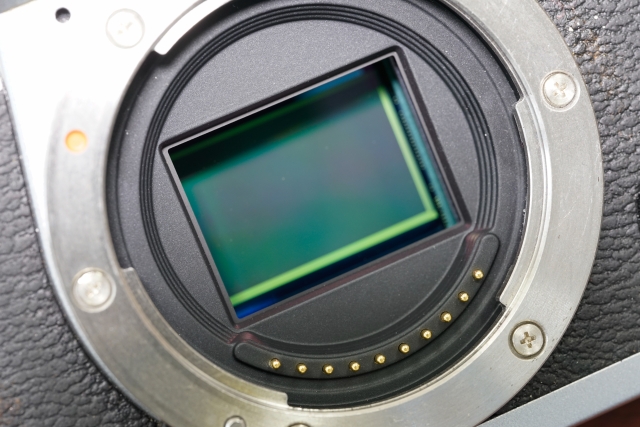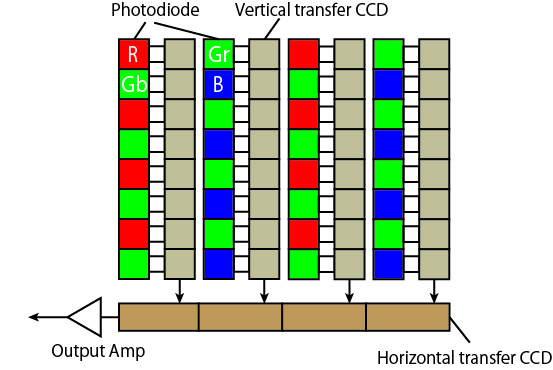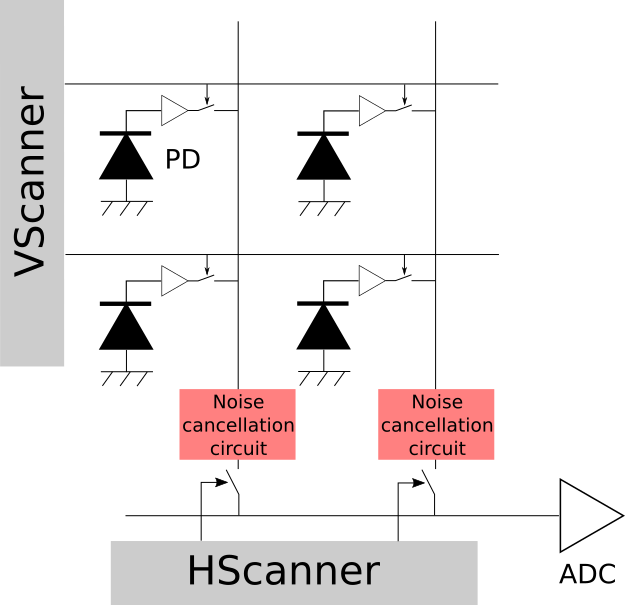What is an image sensor? This page is for those who have heard of them but do not know what they are.
First, we will explain what an image sensor is! If you know what an image sensor is but want to know more about pixels, please refer to the explanation of pixel structure.
If you are not familiar with image sensors at all, we hope you will become interested in them through this site.
Image Sensor?

Image sensors are used everywhere around us. For example, the most familiar examples are smartphones and digital cameras. The sensor used in a camera, which detects light and converts it into an image, is called an image sensor.

An image sensor is basically used in what is called a camera. The image sensor is arguably the most important component of a camera in terms of image quality. A camera using an image sensor with a low pixel count and poor sensitivity will be a camera with poor image quality. Conversely, a camera with a good image sensor will produce a camera with good image quality. Of course, not everything is determined by the image sensor alone, but it is such an important component of a camera that image quality can vary greatly depending on whether the image sensor is good or bad.
These days, everyone is posting photos on social networking services such as Instagram. Rumor has it that 21.9 billion photos are uploaded to social networking sites such as Instagram every year. Most of these photos are taken by image sensors!
It is thanks to the development of image sensors that we are now able to handle photos and videos in such a familiar way. Recently, twin-lens and trin-lens cameras have become the norm in the world of smartphones. And when you look at the images you take, they are very beautiful. When you think back to pictures taken with a cellular phone a decade ago, you can see how the image sensors have become more sophisticated in recent years.

Incidentally, although we have mentioned that image sensors are used for taking pictures and videos with cameras, there are other applications. Other than general applications such as digital cameras and smartphones, image sensors are used in various fields such as in-vehicle cameras, medical cameras, and factory cameras.
Basic Structure of CCD & CMOS Image Sensors
First, there are two types of image sensors: CCD image sensors and CMOS image sensors. The following sections describe the structure of CCD and CMOS image sensors respectively.

- CCD Image Sensor Structure
CCD stands for Charge Coupled Device, and a CCD image sensor consists of a photodiode and a vertical transfer CCD for electrification transfer side by side. The photoelectric charge converted by the photodiode is transferred by the vertical transfer CCD like a bucket relay and then transferred to the horizontal transfer CCD. The charge transferred to the horizontal transfer CCD is converted to a voltage by the final amplifier and output. As a result, fewer companies are able to manufacture CCD image sensors, and the manufacturing process itself is more expensive than that of CMOS image sensors. CCD image sensors also consume more power than CMOS image sensors. Today, CMOS image sensors are the mainstream, but a decade ago, CCDs were the mainstream due to their low noise level.
- About CMOS Image Sensors
CMOS stands for Complementary Metal-Oxide Semiconductor, which in Japanese translates to complementary metal-oxide semiconductor, and one of the main features of CMOS image sensors is that they use the CMOS LSI manufacturing process, which allows them to be manufactured on the same chip as the signal processing and circuitry required for the image sensor. The CMOS image sensor can be manufactured on the same chip as the signal processing circuits, etc., required for the image sensor. Also, since the CMOS image sensor is manufactured using the conventional CMOS process, it can be produced in large quantities with high functionality and compact size.

- CMOS Image Sensor Structure
This section describes the structure of a typical CMOS image sensor. In general, a CMOS image sensor consists of a photodiode, pixel circuit, noise reduction circuit, AD converter, horizontal scanning circuit, and vertical scanning circuit. Light entering the pixel acquires a signal through photoelectric conversion in the pixel and is read out. The noise contained in the signal is then removed by the noise reduction circuit, and the signal with less noise is converted to a digital value by the AD converter. By performing this process for every pixel, pixel values can be acquired across the entire pixel array. In addition, CMOS image sensors are characterized by a high degree of freedom in readout because pixels are selected by an address system.
Summary
Now, let’s review the article in summary.
Q.What is an image sensor?
A.A sensor used in a camera. A sensor that converts light into electrical signals and produces an image.
Q.What are the advantages and disadvantages of CCD and CMOS image sensors?
A.CCD image sensor
◆Advantages
High quantum efficiency, low dark current.
◆Disadvantage
System-on-a-chip is not possible.
CMOS image sensor
◆Advantages
System-on-a-chip capable. High FPS and HDR are possible.
◆Disadvantage
Noise, such as dark current, is high.
CMOS image sensors are still evolving rapidly. Until now, image sensors have been largely developed for digital cameras and mobile devices, but it is thought that in the future there will be a shift from applications for images seen by humans to those recognized by machines, such as for automatic driving vehicles. Let us watch with anticipation how image sensors will evolve in the future!
In this site, we hope to provide basic information on image sensors as well as trends in image sensors.
Thank you for your continued support of this site (Image Sensor Information).
Also, we would appreciate it if you could bookmark this site.
We have also written an article on pixel structure, so please check that as well. ↓↓



コメント